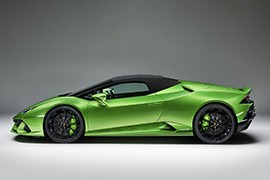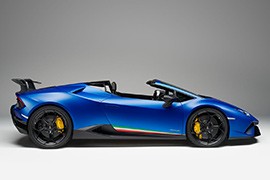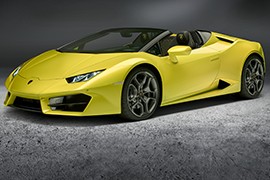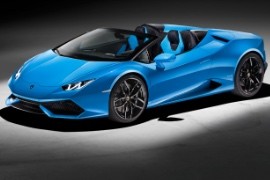LAMBORGHINI Huracan Spyder Models/Series Timeline, Specifications & Photos
First production year: 2015
Engines: Gasoline
Body style: Convertible (spider/spyder, cabrio/cabriolet, drop/open/soft top)
From the moment Lamborghini released the Huracan Evo, customers knew that an open-top version would follow, and the car manufacturer felt obliged to deliver the Spyder.
After five years on the market, the Huracan needed a facelift, and Lamborghini knew that. As a result, in 2019, the Italian car manufacturer introduced the Huracan Evo. It was not just a common facelift with just some new colors and wheels on the options list. It was a vehicle that was closer to the mighty Huracan Performante than the rest of the range. And since the automaker knew that it had a large number of customers who were interested in the open-top version of the Huracan, it delivered the Huracan Evo Spyder. It was a drop-top supercar for those who lived in warmer areas, even though its all-wheel-drive system could handle well on wet and snowy roads.
At the front, the Huracan Evo Spyder featured a completely redesigned lower bumper compared to the 2014 model year. The spoiler included an A-shaped lower air intake integrated into a broad grille. At the same time, on the sides, Lamborghini placed a set of triangular scoops that grabbed air and cooled the front brakes. The automaker added more body-colored elements than on the Performante version.
From its profile, the refreshed Huracan featured body-colored side sills that lowered the ground effect. To emphasize the open-top configuration of the vehicle, Lamborghini painted the A-pillars that supported the raked windshield in piano-black. Furthermore, the same shade was sported by the covers that concealed the retractable fabric roof underneath them. These were installed behind the seats. Unlike the previous Huracan LP 610-4, the Evo version came fitted as standard with 20-inch alloys on both axles. At the rear, the automaker installed a small wing on the deck, behind the engine cover. Unlike the coupe, which featured a large piece of glass above the V10 powerplant, the Spyder was fitted with exhaust vents in the upper area. At the back, Lamborghini installed a broad mesh grille that covered the upper section of the rear fascia. It was interrupted only by the LED taillights. Unlike the previous Huracan that featured four exhausts, the Evo was fitted with two, placed above the diffuser that was underneath the vehicle.
Inside, the most significant update of the car was seen on the center console. Lamborghini replaced the previously used HVAC panel with an 8.4-inch capacitive touchscreen that also controlled the infotainment system and several of the vehicle's driving nannies. The sports seats with high-bolstered areas were wrapped in leather and were available with contrast stitching. Fronting the driver was a flat-bottom steering wheel with paddle shifters behind it and a TFT display inside the instrument cluster. The driver could open or close the fabric roof at the touch of a button in 17 seconds at speeds of up to 31 mph (50 kph).
The 2019 Lamborghini Huracan Evo Spyder featured an upgraded 5.2-liter engine that produced 640 PS (631 hp). The automaker paired it with a seven-speed automatic (dual-clutch) gearbox that sent the power in all corners enhanced with active differentials. The system, known as the LDVI, or Lamborghini Dinamica Veicolo Integrata (Lamborghini Integrated Dynamic Vehicle), helped the driver achieve the best performance on a track. Even though it was heavier than its coupe-sibling, it was still a fast supercar. It could rocket from naught to 100 kph (0-62 mph) in 3.1 seconds, just 0.2 slower than its hard-top sibling.
Lamborghini came with the open-top version of the Huracan Pefromante in 2018, one year after introducing the coupe model at the Geneva Motor Show.
The Italian automaker was already known for creating some of the fastest vehicles on the market. Even the Huracan, which was the access model in the Lamborghini’s lineup, could get to 60 mph (97 kph) from a dig in less than three seconds. The Performante was the race-oriented version of it and could finish the same test in less than three seconds. But it wasn’t only about the straight-line acceleration. It was also about its ability to corner thanks to its active aerodynamics system and the magnetorheological dampers. Unlike the coupe, the open-top version, the Huracan Performante Spyder was created to add more joy to those who drove it around race tracks and on public roads. The car carried over most of the elements that made its brother so good, and in the end, it lost its roof for a wind-in-the-hair feeling. Nevertheless, it helped its occupants hear the engine’s music better.
At the front, the 2018 Huracan Performante Spyder carried over most elements from its coupe sibling, not from any other open-top version of the Huracan. It featured a broad, A-shaped center air intake in the spoiler with an integrated electric motor into the carbon fiber frame that adjusted a set of flaps that increased downforce. In addition, on the sides, the automaker installed the same inward-tilted scoops that cooled the front brakes.
From its profile, the car boasted its large, 20-inch light-alloy wheels on both axles. Its A-pillars that supported the raked windshield were black, matching the color of the door mirror caps. Furthermore, Lamborghini used the same shade to paint the side sills and the lid that covered the retractable roof behind the seats. On the deck, the automaker installed a big carbon fiber wing that increased downforce at higher speeds. Finally, on the rear fascia, the Huracan Performante Spyder featured a broad diffuser under the bumper and two exhausts above it in the center section. A honeycomb mesh covered the area between and underneath the taillights that sported the Y-shaped LED lights.
Lamborghini installed a pair of sports seats inside the cockpit with high bolstered areas and integrated headrests. The contrasting stitching on them and the leather upholstery confirmed the car’s luxurious feeling, even though it was mostly made for fast laps. Fronting the driver was a flat-bottom steering wheel where Lamborghini installed the turn-signal button on the left spoke and the controls for wipers on the right one. On the lower one, there was a red switch that controlled the driving modes: Strada, Sport, Corsa (Street, Sport, Race).
The Huracan Performante Spyder was powered by the same V10 engine installed on its coupe sibling. It produced 640 PS (631 hp) from its 5.2-liter displacement and was paired with a seven-speed automatic (dual-clutch) gearbox. Thanks to its all-wheel-drive system, the car could be easily driven on public roads. But still, since it was heavier than its coupe sibling, it needed more time to do a 0 to 62 mph (0-100 kph) run: 3.1 instead of 2.9 seconds.
LAMBORGHINI Huracan Performante Spyder 5.2L V10 7AT (640 HP)
Lamborghini introduced the open-top version of the Huracan LP 580-2 at the Los Angeles Auto Show eight months after releasing the coupe version of it in Geneva.
The idea of driving an open-top supercar wasn’t new, and Lamborghini knew that. But some of its customers wanted something more thrilling than the safe and sound Huracan 610-4. While the all-wheel drive system made them very easy to drive, the same system was responsible for killing part of the fun since it was more challenging to get the car sideways on corners’ exits. With a rear-wheel drive vehicle, on the other hand, that was easy. But Lamborghini considered that offering the 600+ HP powerplant for it was too much. As a result, the Italian supercar manufacturer reshaped the bodywork of a Huracan Spyder, installed the 5.2-liter V10 from the RWD version, and released the LP580-2 Spyder at the Los Angele Auto Show on November 16, 2016.
At the front, the car looked slightly different than the rest of the Huracan Spyder lineup. The lower bumper featured a trapezoidal center air intake with slightly inward tilted slats compared to the Huracan Spyder 610-4. In addition, the side scoops were horizontally split into two sections, providing more downforce to the front axle. And yet, the angular-shaped headlights and the creases on the hood remained the same. All the front aerodynamic elements, the center grille, and the side scoops, together with the splitter underneath the apron, were black.
From its profile, the Spyder featured black A-pillars that supported the raked windshield. Its large 19-inch front wheels revealed the steel brake discs and the aluminum calipers behind them. Behind the cabin, the automaker installed piano-black panels that concealed the retractable fabric roof. At the back, unlike the coupe, the Spyder featured two rows of vents, one for each cylinder bank, that released the hot air from the engine bay. For the rear fascia, the automaker chose to install four round exhausts mounted lower, integrated into the rear diffuser.
Inside, Lamborghini installed a luxurious cabin. The two sports seats featured integrated headrests, with an option for contrasting stitching to the upholstery. Between the driver and their passenger, the automaker placed a wide center console that housed the red trigger that started the engine, the buttons for the transmission, and the parking brake switch. The driver fronted a 12.3-inch display inside the instrument cluster that doubled as a screen for the infotainment system. Atop the center stack, the automaker placed a pair of hexagonal vents followed on its lower side by the HVAC and infotainment unit buttons.
Under the hood, Lamborghini dropped a de-tuned version of the 5.2-liter V10 engine that already existed in the Huracarn range. The 580 PS (572 hp) was sent to the rear wheels via a seven-speed automatic (dual—clutch) transmission.
LAMBORGHINI Huracan LP 580-2 Spyder (RWD) 5.2 V10 7AT (580 HP)
While creating a coupe supercar was not an issue for Lamborghini, making one with a removable top was a big challenge.
Not only did the fabric roof have to be light and easy to store, but it also had to withstand high aerodynamic forces and keep the car’s clean look regardless of whether it was up or down. However, Lamborghini’s engineering team solved all the problems, and they also reinforced the vehicle’s structure to provide the same driving experience as the coupe version. Even though this process added 203 kg (448 lbs.) to the vehicle, customers loved it and appreciated its performance.
One of the biggest challenges for a car designer is to transform a vehicle from a coupe into a convertible and keep the original lines in place or enhance them. That task was assigned to Filippo Perini, who also penned the coupe. Fortunately, he knew right from the start that the Huracan would evolve into an open-top vehicle when he began working on this model. As a result, both cars were developed side-by-side.
Sporting an overall design similar to its coupe sibling, the Spyder featured a black removable roof that could be retracted at the touch of a button, even while driving at speeds of up to 50 kph (31 mph). The entire process of covering or uncovering the cockpit took 17 seconds, so in the event of a sudden rainstorm, the driver didn’t have to stop. During the process, a remarkable display of technology was showcased, with two triangular fins raised to protect and open the storage area for the roof.
Lamborghini’s team worked some more and created additional elements to create a better cabin for the Huracan. For instance, they added two removable side panels that dampened air turbulences when the roof was retracted so customers could have a conversation at a normal voice level. Inside the cabin, the automaker installed a pair of high-bolstered bucket seats wrapped in leather and with an available two-tone scheme. Furthermore, the Spyder featured a retractable rear window, which could be opened regardless if the top was up or down. In front of the driver, Lamborghini installed the same digital instrument cluster as the one featured in the coupe, and besides the tachometer and speedometer, it could also display the navigation system.
But Lamborghini went even further when it made the Huracan Spyder and offered it with standard ceramic brakes, which were only available as an option on the coupe version. Behind the cabin stood the same naturally aspirated V10 powerplant that sent power in all corners. The 2015 Huracan Spyder was available exclusively with a seven-speed automatic (dual-clutch) gearbox, which replaced the single-clutch system that was offered on the Huracan’s predecessor, the Gallardo.



